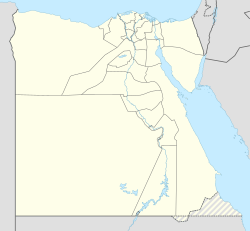Top Qs
Timeline
Chat
Perspective
Abu Hummus
Town in Beheira Governorate, Egypt From Wikipedia, the free encyclopedia
Remove ads
Abu Hummus, also Abu Humus, Abu Hommos, Abu Homos,[2] Abou Homs (Arabic: أبو حمص) is a town in Beheira Governorate, Egypt, an administrative center of markaz Abu Hummus.
The old name of the town is Shubra Bar (Arabic: شبرا بار) or Shunbar (Arabic: شُنْبَار)[3] which Ramzi derives from Chabriou Kome (Ancient Greek: Χαβρίου Κώμη) named after Chabrias.[4] Gauthier derives the modern name from Egyptian hap-m-s "which hides what is in it".[5]
Remove ads
Geography

Located midway between the city of Alexandria and the western branch of the Nile Delta, south of Lake Idku, Abu Hummus spans between the Cairo-Alexandria Agricultural Road and the El-Mahmoudeya Canal.[6]
The town has a Local court, City Town Hall, and a railway station. In 1911 Nakhla meteorite landed in the town.[7][8][9] Many people witnessed the meteorite approaching from the northwest, inclination about 30°, along with the track marked with a column of white smoke. Several explosions were heard before it fell to Earth in an area of 4.5 kilometres (2.8 mi) in diameter, and about forty pieces were recovered;[10] the fragments were buried in the ground up to a metre deep.
Remove ads
Markaz
As of 2007[update], the population of the markaz Abu Hummus was estimated at 348,000.[2] The markaz is known as the site of the Nakhla meteorite.[7]
Notable people
References
Wikiwand - on
Seamless Wikipedia browsing. On steroids.
Remove ads



